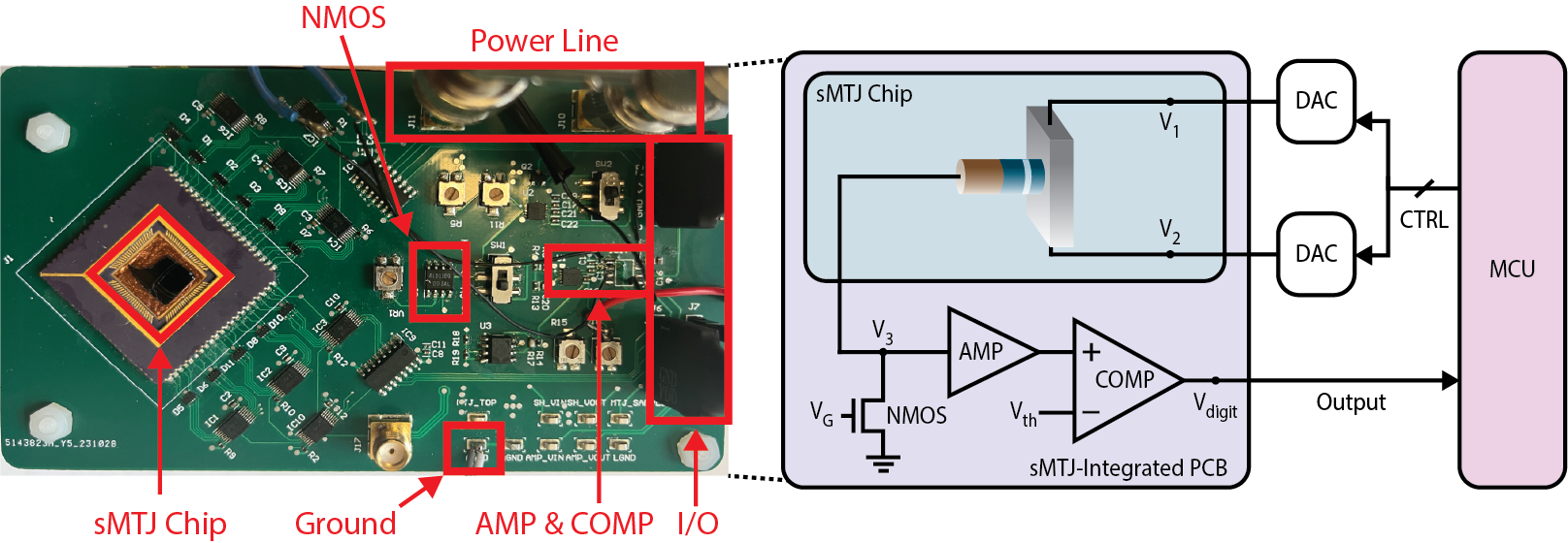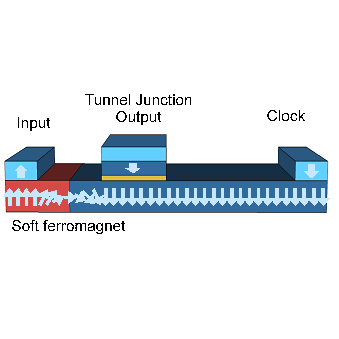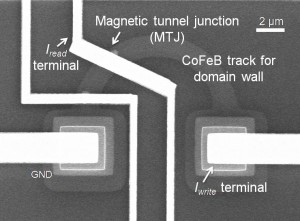Research: Spintronics for Computation
As modern computing systems face growing challenges in energy consumption and processing speed, our work focuses on designing novel devices that go beyond the limitations of conventional silicon-based technologies. One key area of our research involves stochastic magnetic tunnel junctions (sMTJs), which are compact, energy-efficient devices capable of harnessing randomness and probabilistic behavior for advanced computing applications.

Figure: sMTJ chip connected to a printed circuit board for interfacing with an external processor.
By engineering spin-orbit torque sMTJs with enhanced control and reliability, we have demonstrated their potential for AI acceleration, secure computing, and in-memory processing. For example, these devices can act as ultra-low-power random number generators for cryptography or as efficient components in machine learning accelerators, where they naturally perform probabilistic computations. Additionally, we explore how sMTJs can replace bulky, power-hungry analog-to-digital converters in AI hardware, leading to faster and more efficient processing. Beyond individual devices, our research also focuses on integrating these novel components into larger computing architectures, optimizing their functionality for real-world applications. By combining cutting-edge materials science, device physics, and system-level innovations, our research paves the way for future computing platforms that are more energy-efficient, scalable, and capable of handling the demands of emerging technologies.
To learn more on these research works, see our recent publication: Koh et al, Nano Letters 2025.

Figure: Cartoon of the magnetic domain-wall device.

Figure: Microscope image of a fabricated magnetic domain-wall device prototype.
We focus on building digital logic with spintronics as a solution to overcome one of the greatest weaknesses that has emerged in conventional field-effect transistor logic—their power dissipation. We argue that to be robust against noise, all switches should exhibit an energy difference between their ON and OFF states. For example, the potential energy difference between the ON and OFF states of a conventional field effect transistor is ΔE = ½CV2, which can also be expressed as ΔE = ½QV, where Q is the total charge on the gate capacitor, C, and V is the supply voltage. The fundamental limit in the OFF state current is the probability of thermal excitation from the OFF state to the ON state.
That is:
where ION is the maximum current associated with the ON state. But devices do not operate at this limit because each electron in the channel is independent. The actual ON-OFF ratio is determined by:
where q is the charge of a single electron. Thus, in order to achieve a given ratio of IOFF/ION the operating voltage of modern devices is increased beyond theoretical limits by a factor of approximately Q/q. At present transistor dimensions Q >> 103 q, leading to substantial increases in the voltage and dynamic power.
Our solution to this problem is to look for systems where information is stored in a collective phenomenon. For example, instead of using a transistor where every conducting charge is independent, we are interested in states such as the domains of ferromagnets. Strong interactions in these systems, align electron spins collectively. We have been working to translate these phenomena into practical, concatenable digital logic circuits.
In addition to our designs of computing systems with magnetic logic, we also investigate material effects that affect the operation of the magnetic logic device.
For further reading about our device, check out our publication: Currivan et al, IEEE Magnetics Letters 2012.
